ARTICLE AD BOX
38 minutes ago
By Rama Parajuli, BBC Nepali

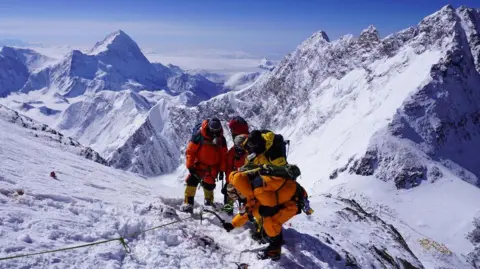 Tshiring Jangbu Sherpa
Tshiring Jangbu Sherpa
The clean-up team removed four bodies from the Himalayas in this year's operation
Tshiring Jangbu Sherpa cannot forget the dead body he saw just metres from the summit of Mount Lhotse in the Himalayas more than a decade ago.
The Nepali was working as a guide for a German climber trying to scale the world’s fourth highest mountain in May 2012. The body blocking their path was thought to be Milan Sedlacek, a Czech mountaineer who’d perished just a few days earlier.
Mr Sherpa was curious why the Czech climber had died so close to the top. One of the gloves on the frozen corpse was missing.
“The bare hand might have slipped away from the rope,” the guide says. “He might have been killed after losing his balance and crashing onto the rock.”
The body stayed where it was - and every climber scaling Mount Lhotse thereafter had to step past it.
Mr Sherpa, 46, had no idea then that he would return 12 years later to retrieve the climber’s body, as part of a team of a dozen military personnel and 18 sherpas deployed by the Nepali army to clean up the high Himalayas.
There have been more than 300 deaths in the Everest region since records of mountain climbing there began a century ago, and many of these bodies remain. The death toll has kept increasing: eight people have been killed so far this year; and 18 died in 2023, according to Nepal’s tourism department.
The government first launched the clean-up campaign in 2019, which included removing some bodies of dead climbers. But this year was the first time that authorities set a goal to retrieve five bodies from the so-called “death zone”, above an altitude of 8,000m (26,247 feet).
In the end the team - who subsisted on water, chocolate and sattu, a mixture of chickpea, barley and wheat flour - retrieved four bodies.
One skeleton and 11 tonnes of rubbish were removed at lower attitudes after a 54-day operation that ended on 5 June.
“Nepal has received a bad name for the garbage and dead bodies which have polluted the Himalayas on a grave scale,” Major Aditya Karki, the leader of this year’s operation, told BBC Nepali.
The campaign also aims to improve safety for the climbers.
Maj Karki says many have been startled by the sight of bodies - last year, one mountaineer could not move for half an hour after seeing a dead body on the way to Mount Everest.

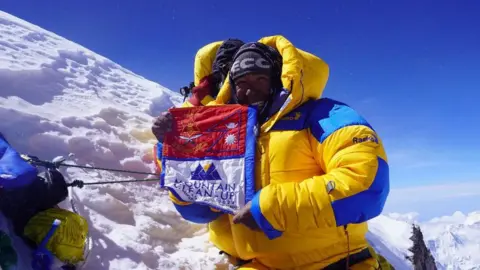 Tshiring Jangbu Sherpa
Tshiring Jangbu Sherpa
Tshiring Jangbu Sherpa shows off a mountain clean-up flag
Cost and difficulties
Many people cannot afford to retrieve the bodies of relatives who have died on mountains in Nepal. Even if they have the financial means, most private companies refuse to help get bodies from the death zone because it is too dangerous.
The military allocated five million rupees ($37,400; £29,000) this year to retrieve each body. Twelve people are needed to lower a body from 8,000m, with each needing four cylinders of oxygen. One cylinder costs more than $400, meaning that $20,000 is needed for oxygen alone.
Every year, there is only about a 15-day window during which climbers can ascend and descend from 8,000 metres, as the winds slow down during the transition between wind cycles. In the death zone, the wind speed often exceeds 100 km per hour.
After locating the bodies, the team mostly worked after nightfall because they did not want to disturb other mountaineers. In the Everest region, which also consists of Lhotse and Nuptse, there is only one single ladder and ropeway for people climbing up and down from base camp.
“It was very tough to bring back the bodies from the death zone,” Mr Sherpa says. “I vomited sour water many times. Others kept coughing and others got headaches because we spent hours and hours at very high altitude.”
At 8,000m, even strong Sherpas can carry only up to 25kg (55 pounds), less than 30% of their capacity at lower altitudes.

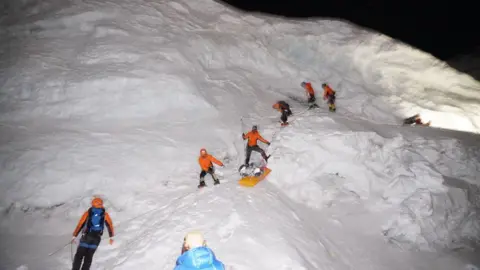 Tshiring Jangbu Sherpa
Tshiring Jangbu Sherpa
The team mostly worked at night near the summit because they didn't want to disturb other climbers
The body near the summit of Mount Lhotse, which stands at 8,516m, was discoloured after exposure to the sun and snow for 12 years. Half of the body was buried in snow, Mr Sherpa says.
All four climbers’ bodies retrieved were found in the same position as they had died. Their frozen state meant their limbs could not be moved, making transportation even more difficult.
Nepali law states that all bodies have to remain in the best condition before they are returned to authorities – any damage could result in penalties.
The clean-up team arranged a roping system to bring the bodies down gradually, because pushing them from behind or pulling them from in front was not possible. Sometimes, the bodies became stuck in the rocky, icy terrain, and pulling them out again was a laborious task.
It took 24 hours non-stop to bring the body presumed to belong to the Czech climber to the nearest camp, which is just about 3.5km away, Mr Sherpa says. The team then spent another 13 hours getting the body down to another lower camp.
Next stop for the bodies was a journey to Kathmandu by helicopter, but the crew was stuck in the town of Namche for five days because of bad weather. They arrived in the capital safely on 4 June.
Identification
The four bodies and the skeleton have been kept at a hospital in Kathmandu.
The army has found identification documents on two bodies – Czech climber Milan Sedlacek and American mountaineer Ronald Yearwood, who died in 2017. The Nepali government will be in communication with the respective embassies.
The process of identifying the other two bodies is ongoing.
Sherpa climbers and guides keep track of the locations and possible identities of lost climbers, so they have provided potential information on some of the bodies. They believe all the bodies belong to foreigners, but the government has not confirmed this.
About 100 sherpas have died on the Himalayas since records began, so many families have been waiting for years to perform the last Buddhist rites for their loved ones.
Authorities have said they will bury the bodies if no one comes to claim them three months after identification – regardless of whether the bodies belong to a foreigner or a Nepali.
Mr Sherpa first climbed in the Himalayas at the age of 20. In his career, he has scaled Everest three times and Lhotse five times.
“Mountaineers have got famous from climbing. The Himalayas have given us so many opportunities,” he says.
“By doing this special job of retrieving dead bodies, it’s my time to pay back to the Great Himalayas.”

 4 months ago
33
4 months ago
33
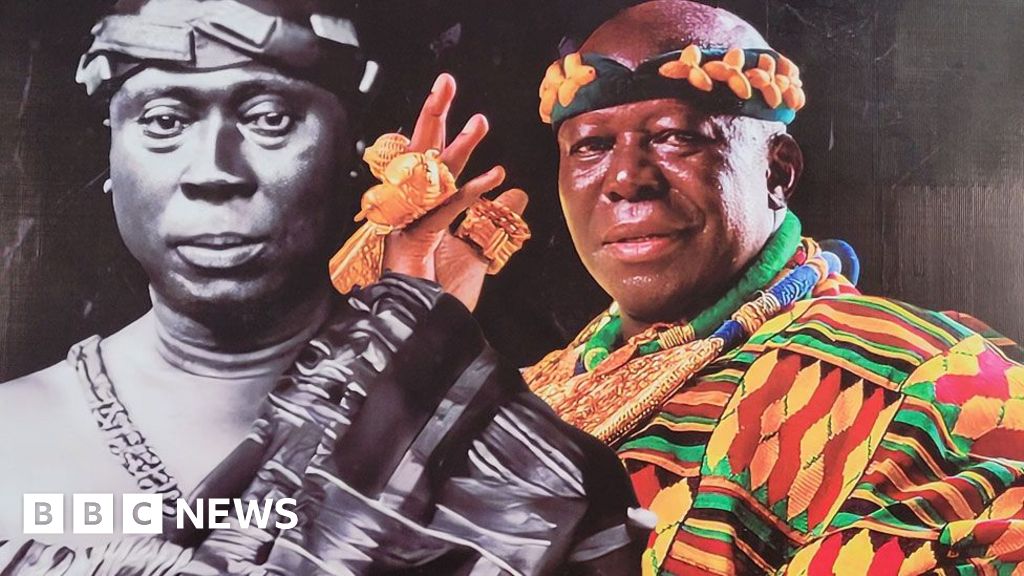
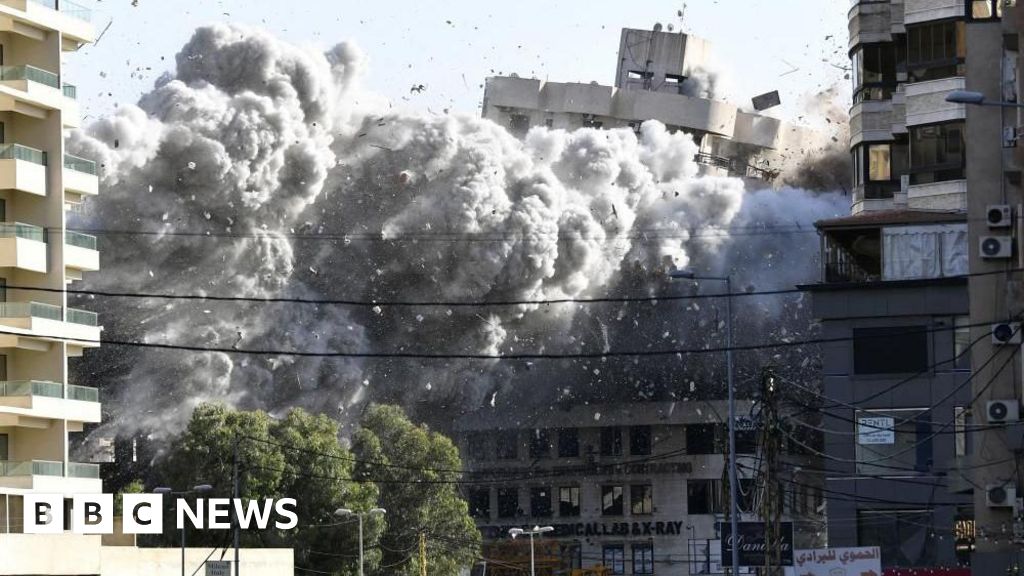
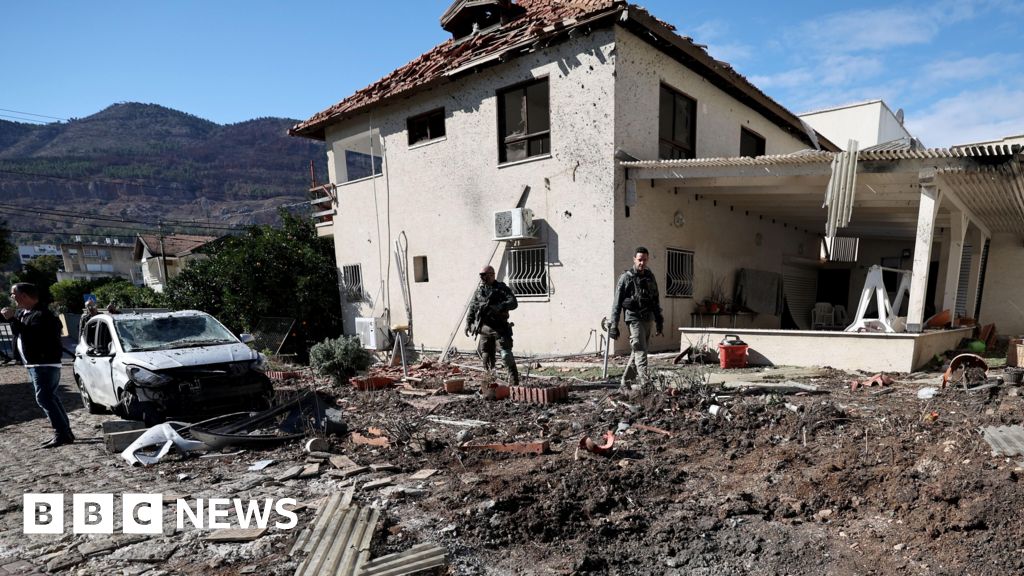





 English (US)
English (US)